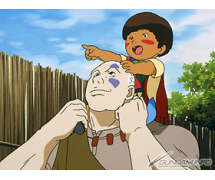4 mai 2013
Gundam School Part 15
Plastic Models (also known as GUNPLA) Part 1
"What is 'Gundam', anyway?" This simple (?) question is answered in our fifteenth casual weekly column just for new fans!
A 15th super-simple "Gundam School" column for new Gundam fans comes hovering out of the Bermuda Triangle!!
Part 1 was Gundam faces and coloring, and then part 2 was masked men and Haro. Part 3 was all about the Universal Century, part 4 was mobile suits, part 5 took on MSVs, and part 6 covered the "Zaku" and "GM", part 7 took on parts swapping, part 8 was an example of mobile suit R&D, part 9 was all about the women of the first Mobile Suit Gundam series, part 10 focused on Gundam's "big brothers", part 11 touched on amphibious mobile suits, part 12 introduced some middle-aged men, and parts 13 and 14 were the first and second parts of our look at Gundam TV themes; this week we've got one more really iconic piece of Gundam.
There's been plenty of Gundam merchandise, toys, and more since Mobile Suit Gundam first hit the airwaves, but none are as popular as the "Gunpla" Gundam plastic models that have become their own unique segment of the modeling industry over the past 30-plus years.
More than 1,000 different kits have been produced.
In part 15, we take out first look at Gundam's "Gunpla" plastic models and how they changed the history of Japanese modeling!
Part 1
What makes a Gunpla? It's more than a toy, it's a social phenomenon!




Mobile Suit Gundam, the first Gundam series, began airing in 1979.
To give a better feel for the zeitgeist of the day: Invaders were munching coins in arcades across the country, an urban legend was spreading about a woman with sliced-open cheeks, (scary!) the first-even nationwide standardized college entrance exam had just been held, and Tokyo was about to host its first-ever G7 summit.
Hideki Saijo's Young Man (a cover of Y.M.C.A.), Godaigo's Monkey Magic, Judy Ongg's Miserasete, and Pink Lady's Pink Typhoon fought for the top of the charts; in fact, this was during the peak of Pink Lady's popularity. You never could have predicted that 20 years later, Hideki Saijo would perform a Gundam theme.
As for prices, tofu was 80 yen a block, taxi rides started at ¥380, the cheapest rail ticket could be bought with a single ¥100 coin, and LPs ran around ¥2,500 (and couldn't be rented.) People couldn't stop talking about the Japanese astrological sign "Tenchusatsu", casual office dress codes to cut the need for air conditioning with high '70s energy prices, or the purported health benefits of pull-up machines. If you wanted a home PC, you could pick up the PC8001 for only ¥168,000 (floppy drive not included!) Meanwhile, for serious business writing, office word processors were less of a bargain at a whopping ¥6,300,000. The first Walkman was about to bring stereo cassettes to the masses, giving a peak at the promise of the golden '80s.
The next year, 1980, brought the Game & Watch, the granddaddy of all handheld games, (!) along with boom boxes, Seiko Matsuda's debut and Momoe Yamaguchi's retirement, the techno-pop boom and Kenji Sawada's hit Tokio, the retirement of Shigeo Nagashima's #3, the peak of Takenoko-zoku activity in Harajuku, and other signs of the bubble era to come. But that's enough reminiscence for now... ( Ed: I was just about to say.) Anyway, Mobile Suit Gundam was broadcast amidst this milieu, and shortly after its run ended in January '80, its impact began to be felt through the first release of the "Gunpla" plastic models. (Salute! )
The popularity of Gunpla formed a feedback loop with the skyrocketing popularity of the anime's reruns, and the two soon fused into a social phenomenon with occasionally-unfortunate results. (That could probably be a column all by itself. *laughs*)
Part 2
What makes a Gunpla? A scale model's feeling of realism!

After the anime finished broadcasting, Gundam's popularity continued increase, and soon the time was ripe to strike with the first Gunpla: the Gundam! (applause)
While it seems unbearably clunky by modern standards, proportioned more like a vinyl toy than a model kit, it still has its charms.
While its arms and head could be expected to bend and turn slightly, it was mostly built to be painted and then stand at attention.
Introduced six months after the anime finished airing, in July 1980, this first Gundam model would go on to shake the very foundation of the modeling world. One of the secrets to its success? Its scale!
It was molded in 1/144 scale, a common scale for military models like fighters and other aircraft.
Gunpla were appealing in part because they were the first science-fiction robots to be modeled to a particular scale, just like a real military model, with all the realistic detail that implies.
You could even display them alongside other models of the same scale. This evolutionary leap, surpassing the plaything status of earlier robots, opened up an entirely new era.
The children who started with Gunpla could easily move on to military and other types of models; in a way, Gunpla ignited the biggest character modeling boom Japan has ever seen, and changed the history of Japan's plastic model industry.
A price of ¥300, lower than many competing toys, also helped boost Gunpla's popularity among children.



This "¥300 Gunpla" series of kits went on to include not just the Gundam, but plenty of other hit mobile suits!
And what's more amazing, the same kits are still available for ¥315 (after tax) today! Isn't that wonderful?
Whether you were a fan in '80 or you hadn't even been born, (laughs) why not go out and pick up a good old-fashioned kit today?
 Gunpla were also released in other scales. The 1/144 Gundam was accompanied by a 1/100 Gundam for ¥700 (¥735 with tax today.) Just like modern kits, the larger scale allowed for greater detail. You could remove and transform the Core Fighter, or even display it propped up on its landing gear! The hips and ankles were still immobile, but the more extensive craftsmanship is visible in its back-stowable shield and brand-new rocket launcher.
Gunpla were also released in other scales. The 1/144 Gundam was accompanied by a 1/100 Gundam for ¥700 (¥735 with tax today.) Just like modern kits, the larger scale allowed for greater detail. You could remove and transform the Core Fighter, or even display it propped up on its landing gear! The hips and ankles were still immobile, but the more extensive craftsmanship is visible in its back-stowable shield and brand-new rocket launcher.
 In December of the same year, they were followed with a 1/60 RX-78 Gundam. At ¥2,000, (¥2,100 with tax now) its greater scale was matched with a higher price but yet more detail.
In December of the same year, they were followed with a 1/60 RX-78 Gundam. At ¥2,000, (¥2,100 with tax now) its greater scale was matched with a higher price but yet more detail.
Just like the 1/100 kit, the Core Fighter could be removed and transformed. Its legs could be posed spread, and it included both standard clenched and open manipulators. It even included a Gundam hammer and a 1/60 Amuro figure!
Of course, there were plenty of Zeon mobile suits to oppose the Gundam, including a 1/60 Char Custom Zaku ("MS-06S Char's Zaku") with a 1/60 Char figure and a mono-eye that really lit up using a tiny light bulb!


And that's our 15th column, "Gundam's 'Gunpla' plastic models, part 1." We've peeked at the birth of Gunpla and the the first few stages of its life.
Man, I wish I could've seen it for myself. (Might've been kinda scary though...)
Gunpla was born in 1980, but its future still lies ahead of it! But that's for next time, when we cover the ever-increasing quality of Gunpla in "Gundam's 'Gunpla' plastic models, part 2."
Oh, isn't Gundam just so fascinating?
Well, well, well, well, well, well, well, well, well, well, well, well, well, well, well, that's it for this week. Next week we'll be taking another laid-back look at what makes Gundam Gundam!
by Ema Baba
A 15th super-simple "Gundam School" column for new Gundam fans comes hovering out of the Bermuda Triangle!!
Part 1 was Gundam faces and coloring, and then part 2 was masked men and Haro. Part 3 was all about the Universal Century, part 4 was mobile suits, part 5 took on MSVs, and part 6 covered the "Zaku" and "GM", part 7 took on parts swapping, part 8 was an example of mobile suit R&D, part 9 was all about the women of the first Mobile Suit Gundam series, part 10 focused on Gundam's "big brothers", part 11 touched on amphibious mobile suits, part 12 introduced some middle-aged men, and parts 13 and 14 were the first and second parts of our look at Gundam TV themes; this week we've got one more really iconic piece of Gundam.
There's been plenty of Gundam merchandise, toys, and more since Mobile Suit Gundam first hit the airwaves, but none are as popular as the "Gunpla" Gundam plastic models that have become their own unique segment of the modeling industry over the past 30-plus years.
More than 1,000 different kits have been produced.
In part 15, we take out first look at Gundam's "Gunpla" plastic models and how they changed the history of Japanese modeling!
Part 1
What makes a Gunpla? It's more than a toy, it's a social phenomenon!




Mobile Suit Gundam, the first Gundam series, began airing in 1979.
To give a better feel for the zeitgeist of the day: Invaders were munching coins in arcades across the country, an urban legend was spreading about a woman with sliced-open cheeks, (scary!) the first-even nationwide standardized college entrance exam had just been held, and Tokyo was about to host its first-ever G7 summit.
Hideki Saijo's Young Man (a cover of Y.M.C.A.), Godaigo's Monkey Magic, Judy Ongg's Miserasete, and Pink Lady's Pink Typhoon fought for the top of the charts; in fact, this was during the peak of Pink Lady's popularity. You never could have predicted that 20 years later, Hideki Saijo would perform a Gundam theme.
As for prices, tofu was 80 yen a block, taxi rides started at ¥380, the cheapest rail ticket could be bought with a single ¥100 coin, and LPs ran around ¥2,500 (and couldn't be rented.) People couldn't stop talking about the Japanese astrological sign "Tenchusatsu", casual office dress codes to cut the need for air conditioning with high '70s energy prices, or the purported health benefits of pull-up machines. If you wanted a home PC, you could pick up the PC8001 for only ¥168,000 (floppy drive not included!) Meanwhile, for serious business writing, office word processors were less of a bargain at a whopping ¥6,300,000. The first Walkman was about to bring stereo cassettes to the masses, giving a peak at the promise of the golden '80s.
The next year, 1980, brought the Game & Watch, the granddaddy of all handheld games, (!) along with boom boxes, Seiko Matsuda's debut and Momoe Yamaguchi's retirement, the techno-pop boom and Kenji Sawada's hit Tokio, the retirement of Shigeo Nagashima's #3, the peak of Takenoko-zoku activity in Harajuku, and other signs of the bubble era to come. But that's enough reminiscence for now... ( Ed: I was just about to say.) Anyway, Mobile Suit Gundam was broadcast amidst this milieu, and shortly after its run ended in January '80, its impact began to be felt through the first release of the "Gunpla" plastic models. (Salute! )
The popularity of Gunpla formed a feedback loop with the skyrocketing popularity of the anime's reruns, and the two soon fused into a social phenomenon with occasionally-unfortunate results. (That could probably be a column all by itself. *laughs*)
Part 2
What makes a Gunpla? A scale model's feeling of realism!

While it seems unbearably clunky by modern standards, proportioned more like a vinyl toy than a model kit, it still has its charms.
While its arms and head could be expected to bend and turn slightly, it was mostly built to be painted and then stand at attention.
Introduced six months after the anime finished airing, in July 1980, this first Gundam model would go on to shake the very foundation of the modeling world. One of the secrets to its success? Its scale!
It was molded in 1/144 scale, a common scale for military models like fighters and other aircraft.
Gunpla were appealing in part because they were the first science-fiction robots to be modeled to a particular scale, just like a real military model, with all the realistic detail that implies.
You could even display them alongside other models of the same scale. This evolutionary leap, surpassing the plaything status of earlier robots, opened up an entirely new era.
The children who started with Gunpla could easily move on to military and other types of models; in a way, Gunpla ignited the biggest character modeling boom Japan has ever seen, and changed the history of Japan's plastic model industry.
A price of ¥300, lower than many competing toys, also helped boost Gunpla's popularity among children.



This "¥300 Gunpla" series of kits went on to include not just the Gundam, but plenty of other hit mobile suits!
And what's more amazing, the same kits are still available for ¥315 (after tax) today! Isn't that wonderful?
Whether you were a fan in '80 or you hadn't even been born, (laughs) why not go out and pick up a good old-fashioned kit today?


Just like the 1/100 kit, the Core Fighter could be removed and transformed. Its legs could be posed spread, and it included both standard clenched and open manipulators. It even included a Gundam hammer and a 1/60 Amuro figure!
Of course, there were plenty of Zeon mobile suits to oppose the Gundam, including a 1/60 Char Custom Zaku ("MS-06S Char's Zaku") with a 1/60 Char figure and a mono-eye that really lit up using a tiny light bulb!


And that's our 15th column, "Gundam's 'Gunpla' plastic models, part 1." We've peeked at the birth of Gunpla and the the first few stages of its life.
Man, I wish I could've seen it for myself. (Might've been kinda scary though...)
Gunpla was born in 1980, but its future still lies ahead of it! But that's for next time, when we cover the ever-increasing quality of Gunpla in "Gundam's 'Gunpla' plastic models, part 2."
Oh, isn't Gundam just so fascinating?
Well, well, well, well, well, well, well, well, well, well, well, well, well, well, well, that's it for this week. Next week we'll be taking another laid-back look at what makes Gundam Gundam!
[Author profile]
Ema Baba
Scriptwriter. Troublemaking scenarist.
Learning more every day to teach you about the fun of Gundam!
Scriptwriter. Troublemaking scenarist.
Learning more every day to teach you about the fun of Gundam!
PAGES LES PLUS VISITÉES
ARTICLES RECOMMANDÉS
Activez les cookies pour voir les articles recommandés






